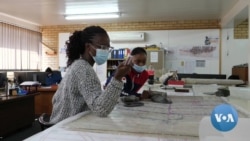The mining industry has long been one of South Africa’s largest sectors, but women are still a minority in its workforce. Now, a group called Women in Mining South Africa is trying to change that through a mentorship program to help young women enter the field.
Baile Sebetlele is a geologist for Harmony Gold Mining. Mining seemed a natural career choice for the 29-year-old with interests in science and exploration.
But with women making up less than 15% of the country’s mining workforce, fitting in did not come as easily. She recalls the first day without her male supervisor by her side.
“I had to go underground on my own, do the actual work," Sebetlele said. "... I got this other man telling me that, ‘No, no, Baile, we’re not going to listen to you. You’re young enough to be my daughter or my granddaughter, so I’m not going to listen to you.’”
Building trust takes time
Six years into her career, Sebetlele said she has built trust with her male colleagues, but the path could have been easier with more support.
That's why the nonprofit Women in Mining South Africa launched a mentorship program for 42 young women, including Sebetlele, this year.
Raksha Naidoo is the deputy chairperson.
“I think that it can become a very lonely journey, when you’re in these very, very male-dominated industries," Naidoo said. "And without having some sort of support or guidance, it can force you to leave the industry a lot quicker than you should. So, there was definitely a need for mentorship.”
Mining has long been a male-dominated industry in South Africa. Women could not legally work underground until 1996.
Barriers for women found
An employer organization called Minerals Council South Africa took a survey about work conditions in the industry. Thuthula Balfour, head of health at the council, said the survey revealed barriers facing women.
“Although it was generally positive, there were still comments around issues of inadequate physical infrastructure, things like those unisex toilets and again, the PPE (personal protective equipment) which is suited for women,” Balfour said.
Sebetlele said it’s also difficult to find work boots small enough to wear.
The minerals council said companies are adapting equipment and the environment to ensure women’s safety and comfort on the job.
Naidoo said Women in Mining is also trying to boost the number of women in the industry by providing career booklets to schools about the many diverse jobs that do not require work underground.
“Young girls, as early as probably grade eight to nine, will start seeing what these different faces look like in these different careers so that they’re able to understand the subjects that they need to take at school," Naidoo said. " ... People are starting to see that it’s not just about putting on a hardhat and overalls.”
For Sebetlele, having a female mentor to talk through the daily challenges at work has made a difference.
Results are encouraging
As she sets her ambitions higher, Sebetlele said seeing other women advance in the sector is encouraging.
“In our corporate office, now with the new appointments, you are seeing women, you’re starting to see women occupying those strategic positions," Sebetlele said. "You’re starting to see young women taking up space ... So, I think any young woman can do it with the right guidance and with the right mindset as well.”
Positive feedback from this year’s proteges has Women in Mining planning to expand its program. The organization is looking at establishing a mentorship program for mid-career women who want to climb the corporate ladder.










